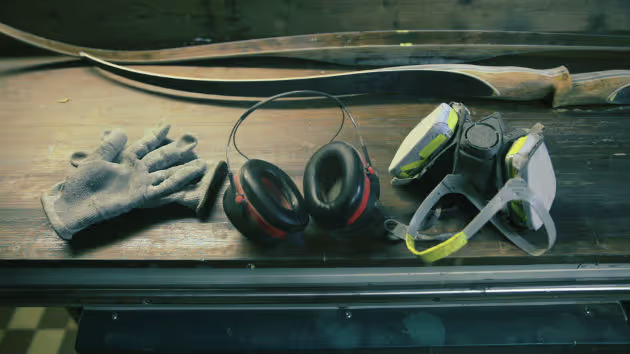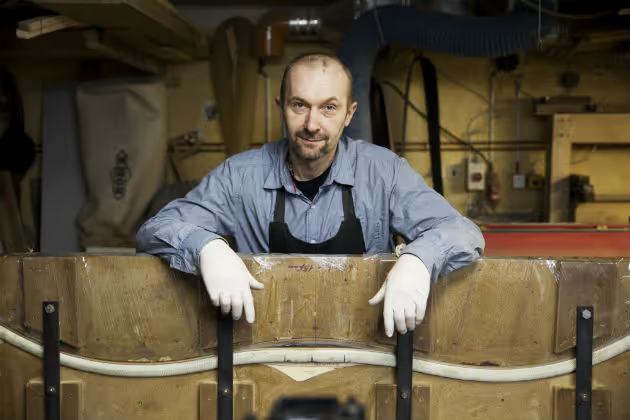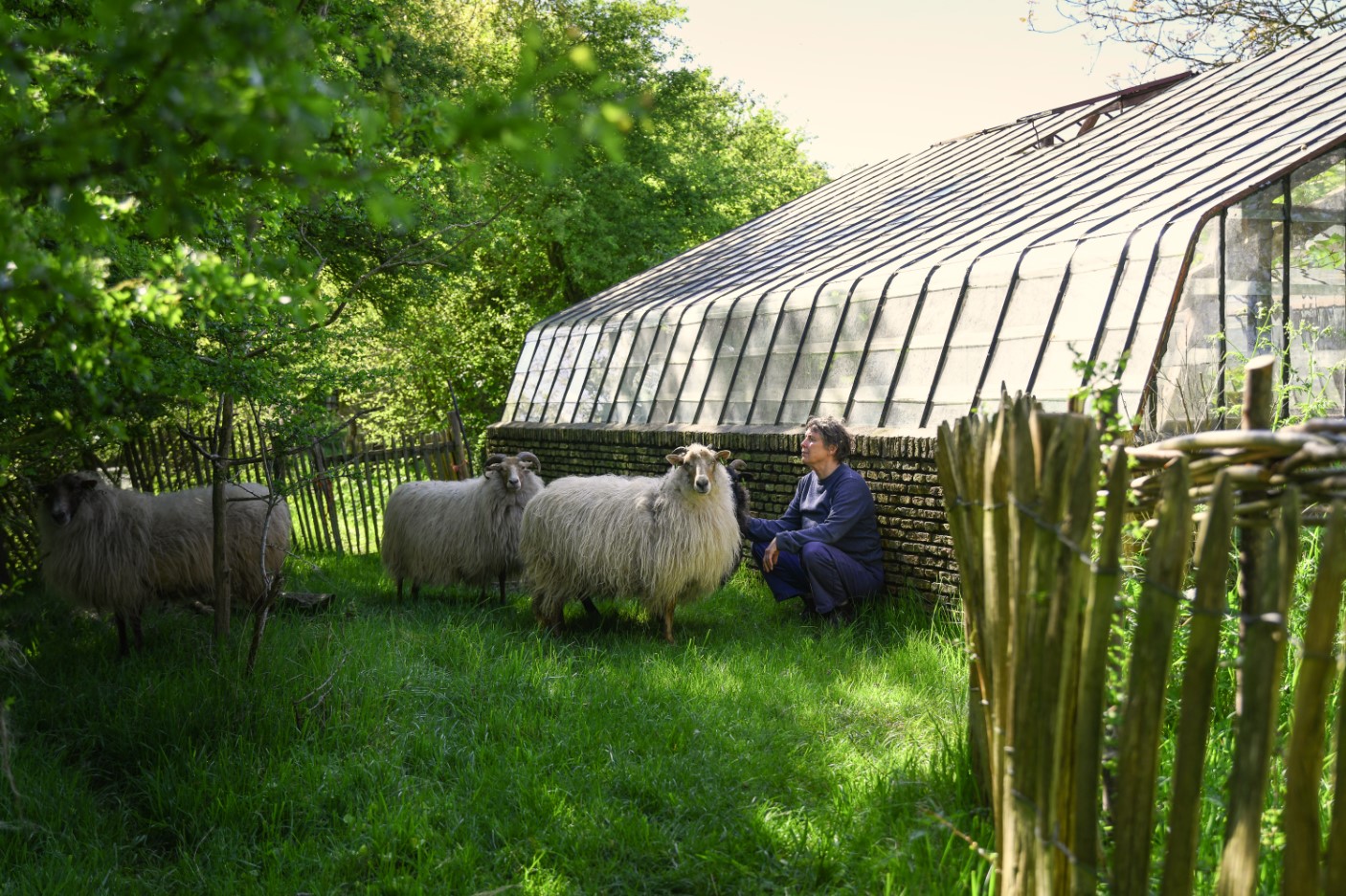► For Czech version click here
Tomáš Hanuš has been drawn to carpentry since his childhood. “The first thing I made out of wood was a slingshot,” he recalls. And he spent his youth playing with that slingshot. Hanuš’s affinity for wood grew, and he went on to train as a carpenter. At first, he earned his living making snowshoes. But then, eleven years ago, he switched to making bows. The change was an entirely organic process: “I was already shooting from bows by then. But I wasn’t happy with any of them. And that coincided with a number of warm winters, and low sales of my snowshoes. So I ended up looking for some kind of new work.”
But how did he learn this new skill? “It was essentially all about getting to know various materials and glues – there is an ocean of available products on the market – and one needs to make sure the right ones are selected. Understandably, there are very few people out there willing to share the secrets of their own experiences in the trade – and so you have to blaze your own path.”
[[VIDEO:https://www.youtube.com/watch?v=PTE41HdP3Os]]
The manufacturing of bows is both technically and mentally challenging. The bow-maker must be precise, technically proficient, skilled as a craftsman, and also have a cultivated aesthetic sensibility. “First comes an idea for the shape. And only when you make it can you see if the idea was a good one,” explains Hanuš, who spent twelve hours a day in his workshop during the first three years after setting out on this path. After a combination of many missteps and successes, Hanuš began to be able to confidently create top-quality bows. Presently, both he, and many of his friends and customers, make use of his products. “When I begin to feel a particular bow is mine, then it becomes part of my family of bows and I will never sell it,” says Tomáš Hanuš, adding that he even gives individual names to all of his bows.
From a dusty workshop in the Krkonoše mountains
Hanuš’s workshop is situated in the northern Bohemian village of Valteřice, just south of the Krkonoše mountain ranges. The bow production process utilises fibreglass, carbon fibre, wood, laminates, and carbon compounds. Epoxy resins are used as glue. The bow-maker finishes the process via cutting and filing – which produces toxic dust, against which he guards with a filter mask. But any romantic notions of a man toiling amidst the smell of aromatic wood, with shavings falling under his feet, are quickly dispelled. “Earlier, bows were made from yew trees; and in our region that meant ash wood. Such materials are excellent for fully wooden bows.” Hanuš then explains that the bows he makes only contain a wooden core – mainly from bamboo or maple.
Some models of bow are made entirely without wood – but if maximum performance is the key factor, then synthetic materials are what is required. In terms of technological advancements, the material gaining the most praise derives from carbon compounds. “This is presented as something of a secret technology, but in reality there is nothing secret about it. Although, in truth, there is nothing to surpass it at the moment. Bows made from this material really are the best on the market. The limbs can be made far lighter than with the use of classic fibreglass.”
The bow-maker explains that the quality of a bow can be determined by the post-shot recoil action felt by the archer’s hand. “Quality bows only experience a minimal recoil.” And he also warns against any false perceptions that a strong bow automatically means a quality bow. “Alas, some people confuse bows with barbells,” he laughs, adding that excessive physical exertion while pulling back on the string comes at the cost of the shooter’s ability to concentrate.

Detailed work
Hanuš also makes use of his archery experience in his communications with customers. Right from the outset, he asks potential customers detailed questions about specifics such as gripping a bow. And then these custom details are used in the creation of the final product. “When an archer then writes to me to express their satisfaction with the finished product, then that is almost more satisfying and fulfilling then being paid for one’s work.”
Despite a well-oiled workshop producing world-class bows, Hanuš retains a down-to-earth philosophy. “There are always, as I like to say, things between heaven and earth – and even when you do everything the way you are used to doing it, then the end result is still not always the one you might expect. But anyone who tries to make something will be familiar with that.”
The main section, responsible for the bow’s strength, is about 80cm long. During production, Hanuš narrows the bow towards its tips. The bow-maker has learnt to file to within three one-hundredths of a millimetre. “And that isn’t easy, because as soon as you file down somewhere erroneously by just tenths of a millimetre, then you might as well cut the bow in two and throw it in the garbage.” For Hanuš, a successfully completed bow is its own reward. “It becomes a polished-up wonder, to which I then only make fine-tuning adjustments. I polish the grooves, thread the bow string, and stick leather of the shelf rest...” After that, the bow-maker heads out into the forest to determine if the finished product shoots in a precise and proper manner.

Concentration, knowledge and arrows
This year, Tomáš Hanuš won the IFAA World Bowhunter Championship, International Field Archery Association competition, and was also crowned European Champion in the IFAA Field Archery Championship. He says he enjoys the variety involved in traditional archery, which utilises three-dimensional targets. “Each target and situation is different; it isn’t just a matter of shooting some pre-determined list of distances. Rather, this requires traversing a track, with around thirty targets, and each of these requires a different approach.”
Absolute concentration is crucial. “You can’t be carrying the baggage of some personal problems with you to the place where you are shooting. Be it joy or sorrow, all such emotions are entirely undesirable during archery. If an archer picks up a bow and is burdened by a negative mindset, then even someone who is otherwise an excellent shooter will find themselves unable to hit a target.” Holding a bow in one’s hand while running a film of personal problems through one’s head is something he certainly does not recommend: “Either you will accidentally hit someone, or you will waste countless arrows, because you won’t be able to hit your target.”
Hanuš also praises the old-fashioned aspects of the sport: “Traditional archery is full of unknowns. If I am not concentrating, then I won’t do well, and will waste quite a few arrows,” he says, suggesting that in such cases the best thing is to simply end the practice session. When a shot fails, what is required is a quick mental reset. And conversely, the conditions that led to a successful shot need to be stored and cultivated. “Shots that turned out well can then be used as inspiration for the next target,” explains Tomáš Hanuš, underscoring how the human mindset can impact the quality of a shot. And sometimes he tries to gauge which of his fellow competitors might do well or buckle under the pressure on a given day. “The bow can tell us quite a lot about a person. Because I have been shooting for quite some time, I am quite good at figuring out the traits of other shooters.”

Grabbing a useful branch
A traditional bow contains no sights or weighting to make a shooter’s job easier. “It is essentially still the same wooden branch which was used to shoot an arrow at the dawn of civilisation; only today it is made from carbon compounds, laminates, and utilises the most modern technologies,” exclaims the bow-maker. “It is basically something that bends. And if someone wants to shoot with such a bow, then they have to accept that at the start they won’t be able to hit a one-by-one metre target from fifteen metres. They have to start out with the mindset that they will have to keep shooting over and over again, without really knowing for some time what they are doing. And they will have to develop their own technique; ideally someone will advise them at the start on how to stand so as to not ruin their bodies.”
Typically, a shooter first trains to pull back on the bow – meaning to repeat the same motion, so as to achieve the same quality of shot. “A difference of one or two millimetres in aim, at a distance of thirty metres, can mean a deviation from target of as much as thirty centimetres, meaning the shooter will either under or overshoot.” After that comes training in taking aim. Hanuš also warns that although many people may be tempted, it is not advisable to skip the first stage (poise). “They try and hit targets right away. But only those archers who are willing to shoot over and over will succeed in firing at targets.”
Archery can help to develop both shooters’ physiques and mental abilities in complex ways. “The levels of concentration you acquire while shooting from a bow can then be usefully adapted to other real-life situations, for example, driving a car – you can learn to suppress the ego in such a way that it does not inappropriately erupt on your behalf,” explains Hanuš.

Hunters’ instinct
A shooter stands in front of a dummy animal – and immediately this triggers a hunters’ instinct. The dummy does not feature a precise target to hit. “When a target isn’t there, then we have to find one, and imagine that it is really there.” That, explains Hanuš, is the difference between shooting at a dummy animal and a shining yellow paper target. “When you want to hit some barn doors, then you have to aim at some knag you find in the wood. If you simply shoot at the barn doors then you will hit the barn, but not the doors... When you see the coloured feathers of your arrow ‘blooming’ at its precise target, then that is the greatest pleasure you can have as an archer.”
In terms of dummy animal targets, these are made from polyurethane casts shaped like deer or other forest creatures. According to Hanuš, these are then placed in what remains of our hunting terrains – scot-free. “And by scot-free I mean that if we fail to hit this ‘animal’ target as precisely as we had planned, then – unlike shooting at a real animal – it is not a problem, as it is just a piece of foam.” During our conversation, the bow-maker also says that he believes that the bow is second only to fire and human speech in terms of its importance to human development. After all, says Hanuš, the bow and arrow made obtaining food considerably easier. “And in a sense, we each have some remnants of our hunter ancestors within us. We are almost pre-programmed to be drawn to the bow,” he says, adding that three-dimensional archery is basically a form of mock hunting.

Between heaven and earth
Hanuš then relates the ideal state-of-mind which a shooter should seek to attain: “The field of vision of a shooter narrows to the smallest possible size; everything peripheral to that is a blur. Your head is truly emptied of thoughts, you really think about absolutely nothing; you have no expectations, no ambitions. And that is the only state in which you have a chance of carrying out a successful shoot and hitting your target.”
And what about those rare magical shots that seem to defy physics? “Those are the shots between heaven and earth. But they don’t really happen just by chance – rather, a person finds themselves alone ‘in the zone’, able to fully concentrate, entirely free of distraction.” The archer then relates a story about once forgetting a required target. And so he used a packet of cigarettes instead. Hanuš says he found himself in a forest imbued with a fantastic atmosphere, and placed the pack down on a tree stump. “I have no idea what got into me, but I walked very far back from that spot – about eighty metres. And yet I managed to pin that packet to the stump with my first shot. That is the magic of the moment, when you simply stop, look up at the heavens and tell yourself ‘yes - right now...’ and that was something that cannot be repeated. It happened, and it was divine, and highly fulfilling.”
An archer can attain a state of awareness, during which, as they pull back on the string they already know where the arrow will land. “Even before the arrow lands you already know whether you have hit a precise shot. It is quite well described in Japanese Zen archery (known as Kyūdō),” explains Tomáš Hanuš. And he says he has experienced a similar moment of zen on a number of occasions. “It is a very uplifting experience.” And the bow-maker has even named one of his models Satori (the Japanese Buddhist term for “awakening”). “
And that is sort of how I imagine the moment of enlightenment to be. Some people experience it through meditation, others, for example, while flying in a plane. We are all essentially looking for it. And suddenly this fills us with an indescribable sense of peace and contentment. And it makes sense to actively search out, and do something to attain, that kind of moment. And the means by which each of us attain this is up to us as individuals.”
Text: Tereza Lišková, photo and video: Tomáš Princ, translated by Dominik Jůn
• contact: Tomas Hanus / ARNI •




%20(2)%20kopie.jpg)